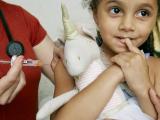Aug 22, 2011
Narcolepsy onset most common in spring, after flu season
Narcolepsy appears to follow seasonal patterns of influenza and other upper airway infections, with an onset most commonly in April and a threefold increase after the 2009 H1N1 flu pandemic, according to a study of Chinese patients published today in Annals of Neurology. Researchers from Beijing University, Stanford University, and Case Western Reserve University analyzed self-reported onset dates from 620 patients with narcolepsy, 86% of whom were children, in Beijing from 1998 through 2010. They wrote in the study, "The occurrence of narcolepsy onset was seasonal, significantly influenced by month and calendar year. Onset was least frequent in November and most frequent in April, with a 6.7-fold increase from trough to peak." The threefold increase after the 2009 pandemic, they write, is unlikely caused by increased vaccination, as only 8 of 142 (5.6%) postpandemic patients said they received the H1N1 vaccine. "Together with recent findings, these results strongly suggest that winter airway infections such as influenza A (including H1N1) and/or Streptococcus pyogenes are triggers for narcolepsy," the authors wrote. A Stanford press release today stated, "The paper doesn't show cause and effect, but it does show a strong correlation between narcolepsy onset and this seasonal pattern."
Aug 22 Ann Neurol abstract
Aug 22 Stanford press release
Study: 1918 pandemic flu deaths followed earlier pneumonia pattern
Prepandemic deaths due to pneumonia were a much better predictor of mortality during the 1918 influenza pandemic than were prepandemic deaths due to influenza, according to a new study by Mexican and US researchers. The researchers examined annual death rates from pneumonia and influenza from 66 large US cities from 1910 through 1916, as well as the pandemic years of 1918 through 1920. They found a strong association between prepandemic pneumonia and pandemic death rates (P < 0.001), but only a weak correlation between prepandemic flu deaths and pandemic flu deaths. They also found that smaller cities suffered a disproportionately higher per capita flu mortality rate than did larger ones in 1918, while city size did not affect pneumonia prepandemic and pandemic mortality rates.
Aug 19 PLoS One study
Indonesia produces its first H5N1 vaccine strain
Scientists at Indonesia's Airlangaa University have created an H5N1 avian influenza vaccine seed strain that could be used to immunize humans, the Jakarta Post reported yesterday. Dr Chairul Anwar Nidom, who heads the lab that created the vaccine strain, said the project, which began 6 months ago, cost $234,000 and involved collaborators from Japan. Nidom told the news outlet Tempointeraktif.com that the seed strain is the first to be produced by Indonesian experts and involves an Indonesian H5N1 virus. "There is no more reason why research has to be conducted abroad, because research could be conducted locally," he said. In 2006, a controversy erupted over the global sharing of influenza viruses when Indonesia started withholding samples to protest the high cost of commercial vaccines made from the viruses. In April a WHO working group finalized negotiations on a final agreement, which clarified the rights and roles of countries. The pact was approved by the World Health Assembly in May.
Aug 21 Jakarta Post story
Minority groups in Northern Territory hit harder by H1N1
Indigenous populations in Australia's Northern Territory contracted 2009 H1N1 flu at almost double the rate of nonindigenous people in that region, according to a serology study. Researchers found that 7.6% of 445 blood samples collected before the pandemic showed protective immunity (hemagglutinin inhibition antibody titer > 40). Of 1,689 samples collected in September 2009 (after the summer 2009 pandemic peak in that region), 19.5% showed protective immunity, for a population-standardized attack rate of 14.9%. Nonindigenous residents had a 12.4% attack rate, compared with 22.9% for Aboriginals and Torres Strait Islanders. In addition, those 14 years old and younger had an attack rate of 36.0%. The authors conclude, "Given that in all groups, the majority of the population is likely to remain susceptible to the virus following the pandemic, vaccination campaigns and public health responses are essential and should focus on high-risk groups, which requires respectful engagement with communities."
Aug 19 Emerg Infect Dis study
Virginia warns of measles exposure on train
Virginia health official yesterday warned passengers who rode an inbound Amtrak train on Aug 17 that they may have been exposed to measles. The Virginia Department of Health (VDH) said in a press release that the alert applied to passengers on Amtrak's Northeast Regional train #171 that originated in Boston at 8:15 a.m. that day and made stops in Maryland (fours stops), the District of Columbia (Union Station), and Virginia (six stops), where it ended in Lynchburg at 8:36 p.m. Maribeth Brewster, spokeswoman for the VDH, told the Washington Post that the patient is a foreign visitor to northern Virginia who boarded the train in Philadelphia, before its Maryland stops. The VDH said the warning does not apply to people who departed the train before it arrived in Philadelphia. It said based on the exposure timeline, people who were potentially exposed could start having symptoms as late as Sep 7.
Aug 21 VDH statement
In other measles developments, the Minnesota Department of Health (MDH) said it and partners in Dakota County are investigating two measles infections in young children. One is in a 12-month-old child who got sick in early August shortly after returning from Kenya, where the disease is endemic, the MDH said in an Aug 19 statement. The child is hospitalized in critical condition. The second child, age 15 months, got sick after visiting the family of the first child and is also hospitalized. Neither had been vaccinated against the disease. Dr Aaron DeVries, medical director for infectious disease epidemiology, prevention, and control at the MDH, said in the statement that vaccination is especially important for those traveling to areas where measles is more common. Though typically the first measles, mumps, and rubella (MMR) dose is given at 12 to 15 months of age, for children who will be traveling internationally it can be given at 6 to 12 months.
Aug 19 MDH statement


















